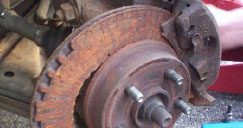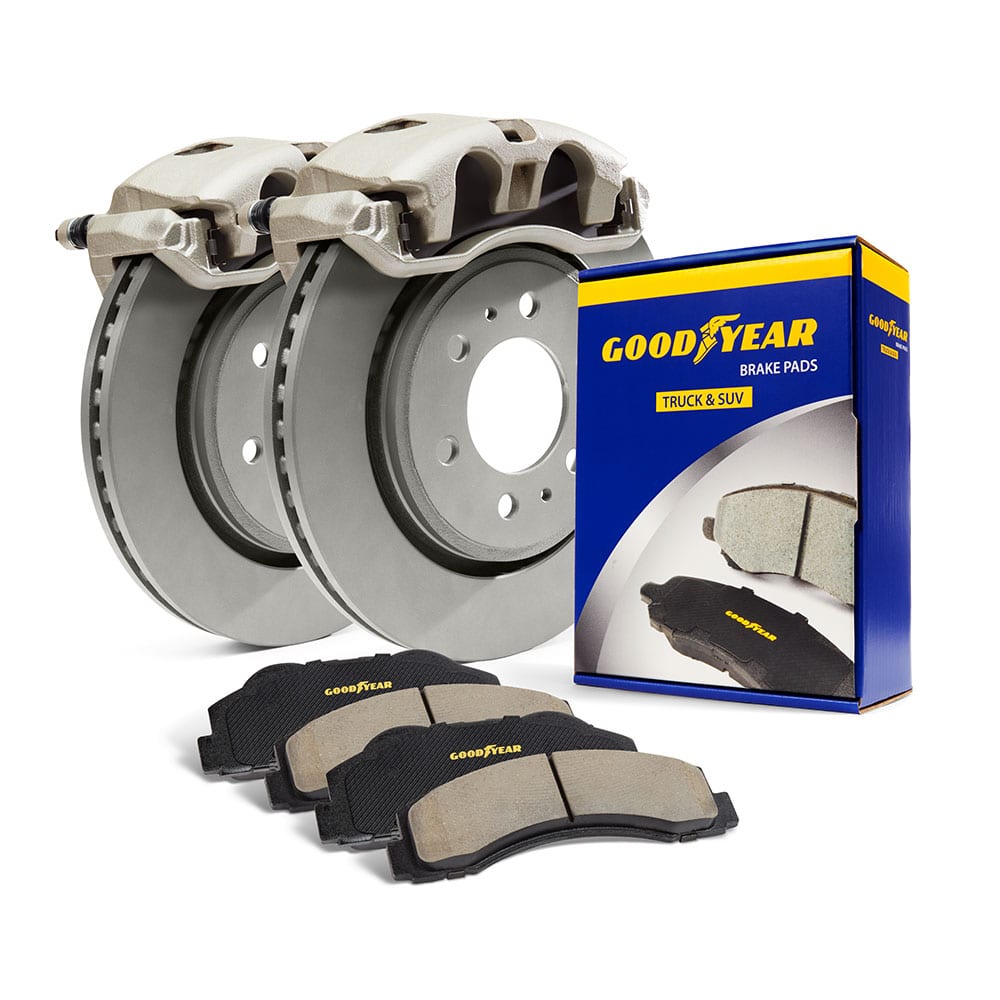How do you know when to change your brakes? A general rule of thumb is to replace your brake pads every 35,000 miles — but rules of thumb only get you so far. What if you have high-performance pads installed? Or what if you live out in the country and you don’t have to deal with heavy traffic every day? What about other key components of the braking assembly, such as calipers and rotors?
The automotive experts at FDP Virginia Inc., which develops and sells Goodyear Brakes, offer some tips for assessing the health of your vehicle’s braking system, as well as advanced solutions for addressing any issues. The new line of Goodyear Brakes provides premium quality brake kits, calipers, rotors, brake pads that are made in the U.S.A., and all the hardware for today’s most popular vehicles, from daily drivers to SUVs and light trucks, all backed by a national warranty, decades of production experience and one of the best-known names in automotive excellence. The Goodyear Brakes product lineup offers the ideal solution for almost every braking need – whether you are looking to save money on your vehicle repairs, upgrade your performance or restore your perfect car.
Consider that your brakes degrade a little bit every single time you use them. Because brakes are so important to car safety, they give you clear signs when it’s time to replace them. Exactly when that is — and what those signs are — varies from car to car and across different environments.

How Do I Know When to Change My Brakes?
Though brake pads are made of resistant material, they’re put under immense strain every time you hit the brakes, and eventually, they’ll wear away completely. Before that happens, you’ll notice a series of changes in how they’re looking, sounding and functioning.
- Brake pads are worn thin — The easiest way to tell if your brake pads need to be replaced is just to look at them. You should be able to see how thick your brake pads are through the spokes of your wheel. If your brake pads are less than a quarter-inch thick (about the same width as a pencil), this means they’re ready to be replaced.
- Brakes are making screeching, squealing, or grinding sounds — Brake pads are designed to give you auditory feedback when it’s time to change them. Depending on your car and the type of brake pad you have installed, a number of different sounds can clue you in. Are your brakes screeching or squealing all the time? It’s normal to hear a squealing sound if you hit the brakes at high speed or if you’re braking in wet weather conditions. What isn’t normal is hearing your brakes squeal nearly every time they’re applied. Constant squealing indicates that your brake pads might be worn down. You also want to listen up for a deeper grinding noise. Some brake pads have a small, embedded metal finger that will start to scrape against the rotor as the pad wears out. If you hear your brakes grinding, this means that your pads are likely in need of replacement.

- Your brake pedal is vibrating — Brake pedal vibration points to worn brake pads, but it also indicates issues with your rotor. Pedal vibration can make it harder to brake and can increase stopping time. If you feel your brake pedal vibrating, it’s likely time to think about replacing your brakes.
When Should I Change My Rotors?
Rotors are what physically bring your car to a stop when the brake pads clamp down on them. They’re disposable and have a wide range of life expectancies anywhere between 15,000 and 70,000 miles. Brake pads play a big role in determining how long a brake rotor will last. Every time a pad clamps down on a rotor, it erodes part of that rotor, visible in the form of brake dust. Aggressive pads with a large clamping force will wear away rotors far faster than other pads.
- Rotors are stained or “dishing” — There are a number of visual signs that can tell you it’s time to replace your rotors. Blue rings and spotting begin to appear when your rotors are unable to effectively dissipate heat. “Dishing” takes place when your rotors are worn away unevenly. This can result in your rotors having a slightly concave surface. You can touch your rotors (after they’ve cooled down) to check them for dishing.
- The steering wheel shudders — Shudder—a pulsing vibration that can be felt through the steering wheel—is a sign that your rotors need to be replaced. Shudder often takes place when rotors in poor condition are warped. Brake pads make contact with the rotor across its uneven contour, causing a pulsing shudder. Shudder might also indicate unbalanced tires, so be sure to check for other signs of rotor wear before replacing them.
When Should I Change My Brake Calipers?
Your brake calipers house the brake pads. Hydraulic pressure on the calipers is what actually causes the brake pads to clamp on the rotor. Calipers are built to handle the stress, but their seals are made of rubber and will harden and break down over time. You should start thinking about replacing your calipers every five to 10 years to be safe. But how can you tell when your calipers are worn out?
- Calipers show signs of corrosion — If your car is five to seven years old and has more than 70,000 miles on it, it’s a good idea to give your calipers a careful inspection to see what condition they’re in. Corrosion is the biggest risk when it comes to calipers. Because of the extreme conditions they operate in, any moisture that builds up in and around your calipers turns to steam, then condenses again. Steam and constant temperature changes corrode the caliper assembly and attack the seals. If there are clear signs of corrosion, rust or leakage you’ll want to replace your calipers, even if you aren’t experiencing brake issues.
- Car drifts while braking — Drifting to one side while braking is a dangerous consequence of worn-out brake calipers. Worn calipers seize up, causing brake pads to apply pressure unevenly to rotors. This can cause your car to move unprompted toward one side or the other when breaking. If you ever experience this, new calipers—and possibly a whole new brake assembly—are likely required.
Your car’s brake assembly works under tremendous pressure and heat. Every time you hit the brakes, you’re wearing out your braking parts a little more. Your brakes will give you clear signals that it’s time to replace them, though, so it’s always a good idea to keep an eye out for signs that your assembly needs attention.
The Goodyear Brakes product line is available through www.GoodyearBrakes.com at Amazon, CarID, BuyBrakes.com, Amazon, Walmart and autoanything.com. For more information about Goodyear Brakes, visit www.Goodyearbrakes.com, call 877.GET.BRKS (877.438.2757) and follow on Facebook, Twitter, LinkedIn, Instagram and YouTube.
FDP Virginia is the company developing and selling Goodyear Brakes. Goodyear (and Winged Foot Design) and Blimp Design are trademarks of The Goodyear Tire & Rubber Company used under license by FDP Virginia Inc., 1076 Airport Road, Tappahannock, VA 22560, USA. Copyright 2021 The Goodyear Tire & Rubber Company.
Goodyear Brakes and FDP Virginia are not responsible for its products when they are subjected to improper applications installation or accident.

